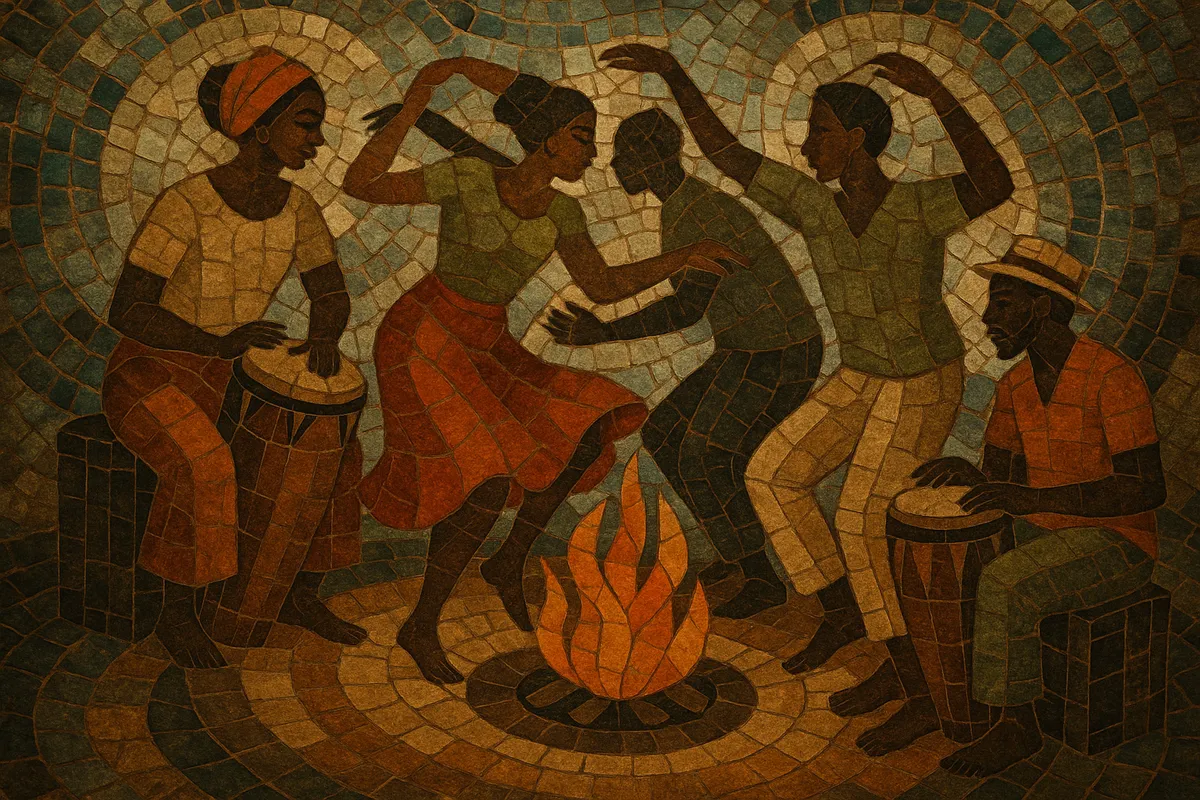Jongo is an Afro-Brazilian circle dance and song tradition from the coffee-growing heartlands of southeastern Brazil, especially the Paraíba Valley spanning Rio de Janeiro, São Paulo, and Minas Gerais. It is typically performed around a bonfire with two drums—the larger caxambu and the smaller candongueiro—driving interlocking rhythms while participants sing call-and-response verses known as pontos.
Rooted in Central and West-Central African (Bantu) cultural memory brought by enslaved peoples, jongo blends ritual, poetry, dance, and social commentary. Dancers invite one another into the circle using the umbigada (a belly-to-belly gesture), and singers improvise metaphor-rich, often enigmatic lyrics that encode devotion, resistance, and wit. In some regions the practice is also called caxambu, reflecting local naming of the larger drum and the tradition itself.
Beyond performance, jongo serves as an intergenerational archive for Afro-Brazilian communities, embodying ancestry, spirituality, and communal cohesion while maintaining a lively, dance-forward character.
Jongo developed in the 1800s among enslaved Africans and their descendants on Brazil’s southeastern plantations, especially in the Paraíba Valley. Its core instruments—the caxambu (large, low drum) and candongueiro (smaller, higher drum)—and its responsorial singing reflect Bantu musical aesthetics from regions of present-day Angola and the Congo. Early jongos functioned as social gatherings, spiritual observances, and subtle vehicles for commentary and solidarity.
Performance centers on pontos (short, metaphor-rich verses) delivered in call-and-response. These texts carry layered meanings—praise, satire, spiritual devotion, and historical memory—often couched in riddles to safeguard messages within hostile environments. The dance circle, opened and animated by the umbigada invitation gesture, reinforces communal bonds and individual artistry.
Following abolition (1888), jongo persisted in rural communities and quilombos, later migrating with workers into urban peripheries of Rio de Janeiro and São Paulo. While sometimes stigmatized or policed, the practice survived through family lineages and neighborhood groups. Its improvisational poetics and percussive swing resonated with evolving urban samba cultures, informing verse craft, rhythmic phrasing, and circle-based performance dynamics.
From the late 20th century onward, communities organized to safeguard and teach jongo—founding ensembles, festivals, and workshops. In 2005, Brazil’s IPHAN recognized Jongo do Sudeste as an intangible cultural heritage, strengthening documentation, intercommunity exchange, and youth education. Today, jongo thrives in both rural and urban contexts (e.g., Angra dos Reis, Paraty, Madureira, Vale do Paraíba), serving as a living archive and a powerful emblem of Afro-Brazilian identity.
Jongo’s circle format, extemporaneous verses, and drum-driven cadence significantly shaped Rio’s samba traditions, especially the improvisational ethos of partido alto. Its communal ritual and poetic craft continue to inform contemporary Afro-Brazilian performance and pedagogy.


